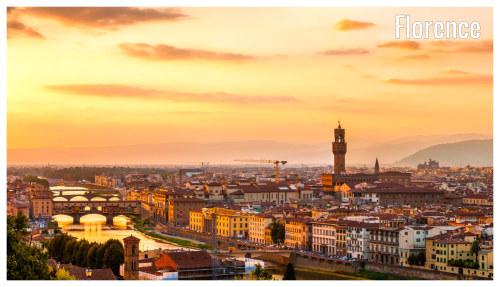Contents
- The climate of Florence
- The best time to visit Florence
- The worst time to visit Florence
- Spring weather in Florence
- Summer weather in Florence
- Autumn weather in Florence
- Winter weather in Florence
- Weather in January
- Weather in February
- Weather in March
- Weather in April
- Weather in May
- Weather in June
- Weather in July
- Weather in August
- Weather in September
- Weather in October
- Weather in November
- Weather in December
- Frequently asked questions
- Average temperature
- Average rainfall
- Average rainfall days
- Average daylight
- Average sunshine
- Average UV index

The climate of Florence
The city experiences a considerable diurnal temperature range annually with average highs soaring up to 31.5°C (88.7°F) and lows plunging to 2°C (35.6°F). Regardless of season, light to moderate rainfall is relatively frequent throughout the year. The highest average rainfall reaches 114mm (4.49") in November while the driest month on average is July with 37mm (1.46") of rain. The city, however, sees an annual shift in the length of daylight from 9 to 15.4 hours.
While UV index varies significantly throughout the year, ranging from 1 in December to 8 during July and August, the duration of sunshine witnesses a proportional increase from 3 hours in January to 10 hours in July. Overall, Florence shows a wide divergence in climatic parameters, making it unique and captivating to travellers and inhabitants alike.
The best time to visit Florence
In addition to favourable temperatures, spring in Florence also offers longer daylight hours, increasing up to 13.5 hours in April, providing ample opportunity to explore the city's rich architecture and art treasures. With the sunshine duration increasing to 6 hours, it is a sublime time to enjoy the blossoming gardens and piazzas that Florence offers.
The worst time to visit Florence
Complementing the increased rainfall, daylight hours are significantly reduced during these months, curtailing to just 9 hours in December. Thus, sightseeing and other outdoor activities can be less enjoyable and somewhat restrictive during this period.
Spring weather in Florence
Summer weather in Florence
Autumn weather in Florence
Winter weather in Florence
Weather in January
Weather in February
Weather in March
Weather in April
Weather in May
Weather in June
Weather in July
Weather in August
Weather in September
Weather in October
Weather in November
Weather in December
Published by: Weather Atlas | About Us
Data Sources | Weather Forecasting & Climate
Frequently asked questions
What part of the year is the coldest in Florence?
How much does it rain in Florence?
What is the month with the least sunshine in Florence?
What is the month with the lowest UV index in Florence?
When are the longest days in Florence?
What is the month with the highest UV index in Florence?
What is the driest month in Florence?
What month has the most sunshine in Florence?
What are the warmest months in Florence?
When is Daylight Saving Time (DST) in Florence?
What is the rainiest month in Florence?
What is the month with the shortest days in Florence?
Average temperature
Florence, Italy

The warmest month (with the highest average high temperature) is August (31.5°C).
The month with the lowest average high temperature is January (10.9°C).
The months with the highest average low temperature are July and August (17.7°C).
The coldest month (with the lowest average low temperature) is January (2°C).
Average rainfall
Florence, Italy

- Average rainfall in January:
60.5mm - Average rainfall in February:
63.7mm - Average rainfall in March:
63.5mm - Average rainfall in April:
86.4mm - Average rainfall in May:
70mm - Average rainfall in June:
57.1mm
- Average rainfall in July:
36.7mm - Average rainfall in August:
56mm - Average rainfall in September:
79.6mm - Average rainfall in October:
104.2mm - Average rainfall in November:
113.6mm - Average rainfall in December:
81.3mm
The wettest month (with the highest rainfall) is November (113.6mm).
The driest month (with the least rainfall) is July (36.7mm).
Average rainfall days
Florence, Italy

- Average rainfall days in January:
8.3 days - Average rainfall days in February:
7.1 days - Average rainfall days in March:
7.5 days - Average rainfall days in April:
9.7 days - Average rainfall days in May:
8.4 days - Average rainfall days in June:
6.3 days
- Average rainfall days in July:
3.5 days - Average rainfall days in August:
5.4 days - Average rainfall days in September:
6.2 days - Average rainfall days in October:
8.5 days - Average rainfall days in November:
9 days - Average rainfall days in December:
8.3 days
The month with the highest number of rainy days is April (9.7 days).
The month with the least rainy days is July (3.5 days).
Average daylight / Average sunshine
Florence, Italy

- Average daylight in January:
9h and 2min - Average daylight in February:
10h and 3min - Average daylight in March:
11h and 5min - Average daylight in April:
13h and 3min - Average daylight in May:
14h and 4min - Average daylight in June:
15h and 2min
- Average daylight in July:
15h and 1min - Average daylight in August:
13h and 5min - Average daylight in September:
12h and 3min - Average daylight in October:
11h and 0min - Average daylight in November:
9h and 4min - Average daylight in December:
9h and 0min
The month with the longest days is June (Average daylight: 15h and 24min).
The month with the shortest days is December (Average daylight: 9h and 0min).
The month with the most sunshine is July (Average sunshine: 10h).
The months with the least sunshine are January, November and December (Average sunshine: 3h).
Average UV index
Florence, Italy

The months with the highest UV index are June and July (UV index 8).
The months with the lowest UV index are January and December (UV index 1).
Florence, Italy
Weather forecast for your location
2. Allow the app to use your location


